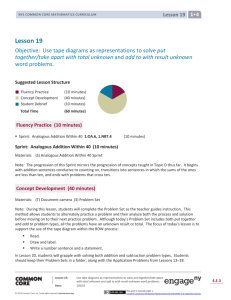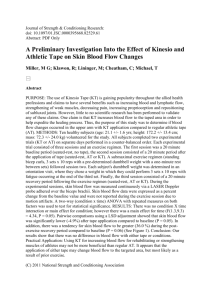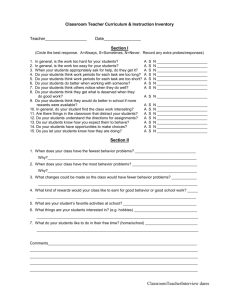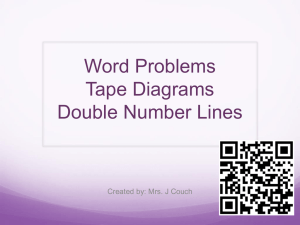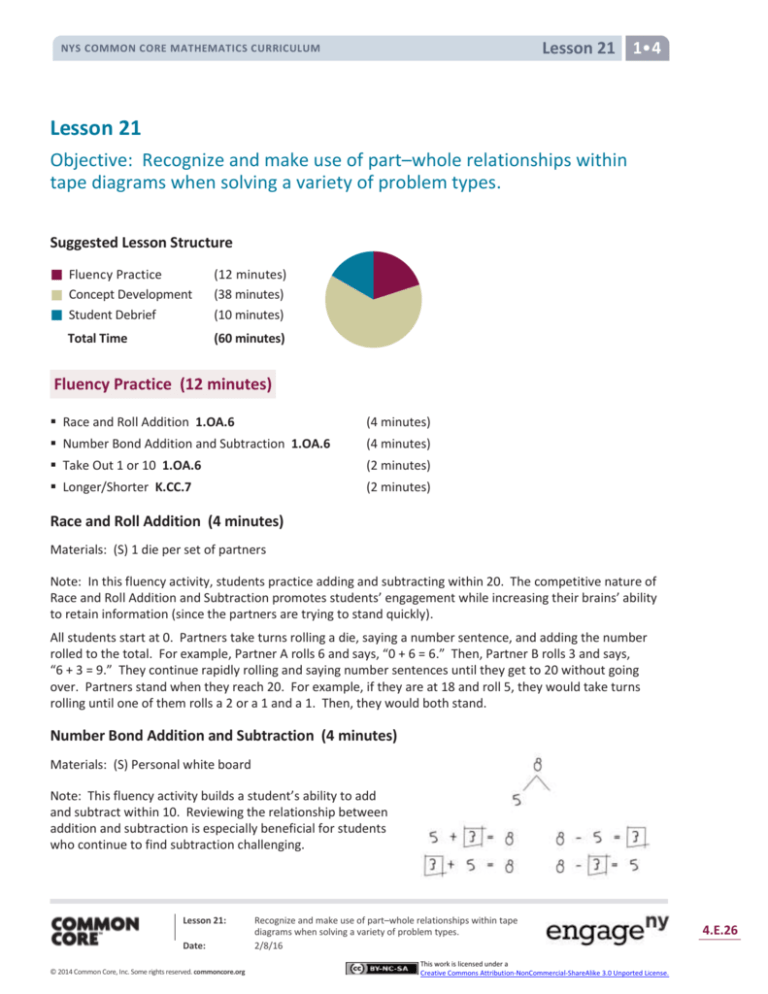
Lesson 21 1•4
NYS COMMON CORE MATHEMATICS CURRICULUM
Lesson 21
Objective: Recognize and make use of part–whole relationships within
tape diagrams when solving a variety of problem types.
Suggested Lesson Structure
Fluency Practice
Concept Development
Student Debrief
Total Time
(12 minutes)
(38 minutes)
(10 minutes)
(60 minutes)
Fluency Practice (12 minutes)
Race and Roll Addition 1.OA.6
(4 minutes)
Number Bond Addition and Subtraction 1.OA.6
(4 minutes)
Take Out 1 or 10 1.OA.6
(2 minutes)
Longer/Shorter K.CC.7
(2 minutes)
Race and Roll Addition (4 minutes)
Materials: (S) 1 die per set of partners
Note: In this fluency activity, students practice adding and subtracting within 20. The competitive nature of
Race and Roll Addition and Subtraction promotes students’ engagement while increasing their brains’ ability
to retain information (since the partners are trying to stand quickly).
All students start at 0. Partners take turns rolling a die, saying a number sentence, and adding the number
rolled to the total. For example, Partner A rolls 6 and says, “0 + 6 = 6.” Then, Partner B rolls 3 and says,
“6 + 3 = 9.” They continue rapidly rolling and saying number sentences until they get to 20 without going
over. Partners stand when they reach 20. For example, if they are at 18 and roll 5, they would take turns
rolling until one of them rolls a 2 or a 1 and a 1. Then, they would both stand.
Number Bond Addition and Subtraction (4 minutes)
Materials: (S) Personal white board
Note: This fluency activity builds a student’s ability to add
and subtract within 10. Reviewing the relationship between
addition and subtraction is especially beneficial for students
who continue to find subtraction challenging.
Lesson 21:
Date:
© 2014 Common Core, Inc. Some rights reserved. commoncore.org
Recognize and make use of part–whole relationships within tape
diagrams when solving a variety of problem types.
2/8/16
This work is licensed under a
Creative Commons Attribution-NonCommercial-ShareAlike 3.0 Unported License.
4.E.26
Lesson 21 1•4
NYS COMMON CORE MATHEMATICS CURRICULUM
Write a number bond for a number between 0 and 10, with a missing part or whole. Today, students write
two addition and two subtraction sentences with a box for the missing number in each equation. They then
solve for the missing number.
Take Out 1 or 10 (2 minutes)
Note: This activity reviews place value to prepare students for Topic F.
Choose numbers between 10 and 20 and follow the paradigm below.
T:
S:
T:
S:
Say 15 the Say Ten Way.
Ten 5.
Take out 1.
Ten 4.
Repeat for 25 and 35. Then, take out 10 from 15, 25, and 35, respectively.
Longer/Shorter (2 minutes)
Materials: (T) Board or document camera
Note: Working with visualizing proportional
relationships between numbers can support
students’ number sense development. By using tape
diagram models, students can recognize methods for
representing numbers in relation to other numbers.
Write one pair of numbers on the board at a time
(e.g., 5 and 5). Draw a rectangle under the first
number.
T:
This rectangle is long enough to hold
this row of 5 dots. (Draw 5 dots so
that they fill the space.)
T: (Point to the second number, which in this first example is also 5.) I’m going to start drawing a
rectangle that is long enough to hold a row of 5 dots of the same size. Tell me when to stop.
T/S: (Begin drawing a rectangle, and give students the chance to say “Stop!” when it is approximately the
same size as the first rectangle.)
T: Why did you say “stop” there?
S: It is about the same size as the first rectangle.
Repeat this process for the following sequence of numbers: 5 and 4, 5 and 10, 1 and 3, 4 and 6, 10 and 20.
Only draw the dots for the first example. Have students talk about how the first number relates to the
second number using language such as a little longer, a little shorter, much longer, double, etc. Have students
who find this challenging use a number line with their left pointer finger on zero and their right pointer finger
on the number (endpoint).
Lesson 21:
Date:
© 2014 Common Core, Inc. Some rights reserved. commoncore.org
Recognize and make use of part–whole relationships within tape
diagrams when solving a variety of problem types.
2/8/16
This work is licensed under a
Creative Commons Attribution-NonCommercial-ShareAlike 3.0 Unported License.
4.E.27
Lesson 21 1•4
NYS COMMON CORE MATHEMATICS CURRICULUM
Concept Development (38 minutes)
Materials: (S) Problem Set
Note: As in Lessons 19 and 20, the suggested delivery of instruction for Lesson 21 is an integration of student
work on Problem Sets with guided instruction interspersed between each problem. If students have been
highly successful with the past days’ lessons, have them try representing the quantities in each part using the
number and label without including the shapes inside each part. The goal is to support students in identifying
a process for making sense of a problem today.
By working with the tape diagrams as drawings related to the varying problem types, students can internalize
an entry point into any problem. Can you draw something? What can you draw? What can you tell from
looking at your drawing? Tape diagrams, even without shapes inside each part, can be considered a type of
drawing. Remember to have students hold on to the Problem Sets so they can use them as a reference later
in the topic.
Suggested Delivery of Instruction for Solving Word Problems
1. Model the problem, calculate, and write a statement.
Choose two pairs of students who have been accurately solving
the Application Problems from Topic D and using simple shapes
in a straight line when drawing. Invite these two pairs of
students to work on chart paper while the others work
independently or in pairs at their seats. Vary the selected
students as the problems become more complex. Review the
following questions before beginning the first problem:
Can you draw something?
What can you draw?
What can you tell from looking at your drawing?
As students work, circulate and support. After two minutes,
have the two pairs of students share only their labeled
diagrams. Give the students two to three minutes to finish
work on that question, sharing their work and thinking with a
peer. All should write their equations and statements of the
answer.
2. Assess the solution for reasonableness.
Give students one to two minutes to assess and explain the
reasonableness of their solution. For about one minute, have
the demonstrating students receive and respond to feedback
and questions from their peers.
Lesson 21:
Date:
© 2014 Common Core, Inc. Some rights reserved. commoncore.org
NOTES ON
MULTIPLE MEANS
OF REPRESENTATION:
Encourage students who have difficulty
moving to the tape diagram
representation as the position of the
unknown changes to draw a number
bond as part of their work. Some
students more easily relate to the tape
diagram through its similarities with
number bonds.
NOTES ON
MULTIPLE MEANS
OF ACTION AND
EXPRESSION:
If students do not have experience with
a context such as the one used in
Problem 2, act out the problem with a
few student volunteers before having
the class begin to draw and solve the
problem.
Recognize and make use of part–whole relationships within tape
diagrams when solving a variety of problem types.
2/8/16
This work is licensed under a
Creative Commons Attribution-NonCommercial-ShareAlike 3.0 Unported License.
4.E.28
Lesson 21 1•4
NYS COMMON CORE MATHEMATICS CURRICULUM
3. As a class, notice the ways the drawing depicts the
story and the solution.
Ask questions to help students recognize how each part of
their drawing matches the story and solution. This will
help students begin to see how the same process can help
them solve varying word problems. Keep at least one
chart paper sample of each solution for reference later in
the lesson.
Problem 1
Rose drew 7 pictures, and Willie drew 11 pictures. How
many pictures did they draw altogether?
This problem, a put together with total unknown, is one of
the easiest problem types. After the students have
explained their drawings and solutions accurately, point to
sections of the tape diagram and ask the class questions
such as, “What does this part represent? How do you
know? What did the student draw or write to help us
remember?”
For the next five problems, move quickly from one to
the next, having only the students at the board share
their work, so that students have time to work through
and discuss all six problems. Choose one or two probing
questions similar to Problems 1 and 2 to support
student development as needed.
Problem 2
Darnel walked 7 minutes to Lee’s house. Then, he walked
to the park. Darnel walked for a total of 18 minutes. How
many minutes did it take Darnel to get to the park?
Problem 3
Emi has some goldfish. Tamra has 14 betta fish. Tamra
and Emi have 19 fish in all. How many goldfish does Emi
have?
Problem 4
Shanika built a block tower using 14 blocks. Then, she
added 4 more blocks to the tower. How many blocks are
there in the tower now?
Lesson 21:
Date:
© 2014 Common Core, Inc. Some rights reserved. commoncore.org
Recognize and make use of part–whole relationships within tape
diagrams when solving a variety of problem types.
2/8/16
This work is licensed under a
Creative Commons Attribution-NonCommercial-ShareAlike 3.0 Unported License.
4.E.29
Lesson 21 1•4
NYS COMMON CORE MATHEMATICS CURRICULUM
Problem 5
Nikil’s tower is 15 blocks tall. He added some more blocks to his tower. His tower is 18 blocks tall now. How
many blocks did Nikil add?
Problem 6
Ben and Peter caught 17 tadpoles. They gave some to Anton. They have 4 tadpoles left. How many tadpoles
did they give to Anton?
Student Debrief (10 minutes)
Lesson Objective: Recognize and make use of part–whole relationships within tape diagrams when solving a
variety of problem types.
The Student Debrief is intended to invite reflection and active processing of the total lesson experience.
Guide students in a conversation to debrief the Problem Set and process the lesson. Look for misconceptions
or misunderstandings that can be addressed in the Debrief.
Any combination of the questions below may be used to lead the discussion.
Look at Problem 1. What did you draw? How did your drawing help you solve the problem?
Look at Problem 2. What did you draw first? How is your drawing similar or different from the
drawing you made for Problem 1?
Look at Problem 3. How did you draw this problem? How is your drawing similar to or different
from your partner’s drawing?
Look at Problem 5. Did you solve this the same way you solved Problem 3, or did you solve it in a
different way? Share your drawing and explain your thinking.
In an earlier lesson, we were looking at smaller, single-digit addition facts inside two-digit addition
problems. Can you find any simpler addition facts inside your number sentences? Share your
examples. How can you draw your tape diagrams in ways that help you see simple problems inside
the larger ones?
Using a highlighter, underline the question in each problem. Highlight the part of the tape diagram
that shows the answer to the question. What do you notice?
Some people write only numbers and not circles inside the parts of a tape diagram. Why might we
want to include the circles in each part? Why might we choose sometimes to use only the number
and leave out the circles in each part?
Exit Ticket (3 minutes)
After the Student Debrief, instruct students to complete the Exit Ticket. A review of their work will help with
assessing students’ understanding of the concepts that were presented in today’s lesson and planning more
effectively for future lessons. The questions may be read aloud to the students.
Lesson 21:
Date:
© 2014 Common Core, Inc. Some rights reserved. commoncore.org
Recognize and make use of part–whole relationships within tape
diagrams when solving a variety of problem types.
2/8/16
This work is licensed under a
Creative Commons Attribution-NonCommercial-ShareAlike 3.0 Unported License.
4.E.30
Lesson 21 Problem Set 1•4
NYS COMMON CORE MATHEMATICS CURRICULUM
Name
Date
Read the word problem.
Draw a tape diagram and label.
Write a number sentence and a statement that matches
the story.
1. Rose drew 7 pictures, and Willie drew 11 pictures. How many pictures did they draw
all together?
They drew _________ pictures.
2. Darnel walked 7 minutes to Lee’s house. Then, he walked to the park. Darnel walked
for a total of 18 minutes. How many minutes did it take Darnel to get to the park?
It took Darnel _________ minutes to get to the park.
3. Emi has some goldfish. Tamra has 14 betta fish. Tamra and Emi have 19 fish in all.
How many goldfish does Emi have?
Emi has _________ goldfish.
Lesson 21:
Date:
© 2014 Common Core, Inc. Some rights reserved. commoncore.org
Recognize and make use of part–whole relationships within tape
diagrams when solving a variety of problem types.
2/8/16
This work is licensed under a
Creative Commons Attribution-NonCommercial-ShareAlike 3.0 Unported License.
4.E.31
Lesson 21 Problem Set 1•4
NYS COMMON CORE MATHEMATICS CURRICULUM
4. Shanika built a block tower using 14 blocks. Then, she added 4 more blocks to the
tower. How many blocks are there in the tower now?
The tower is made of _________ blocks.
5. Nikil’s tower is 15 blocks tall. He added some more blocks to his tower. His tower
is 18 blocks tall now. How many blocks did Nikil add?
Nikil added _________ blocks.
6. Ben and Peter caught 17 tadpoles. They gave some to Anton. They have 4 tadpoles
left. How many tadpoles did they give to Anton?
They gave Anton _________ tadpoles.
Lesson 21:
Date:
© 2014 Common Core, Inc. Some rights reserved. commoncore.org
Recognize and make use of part–whole relationships within tape
diagrams when solving a variety of problem types.
2/8/16
This work is licensed under a
Creative Commons Attribution-NonCommercial-ShareAlike 3.0 Unported License.
4.E.32
Lesson 21 Exit Ticket 1•4
NYS COMMON CORE MATHEMATICS CURRICULUM
Name
Date
Read the word problem.
Draw a tape diagram and label.
Write a number sentence and a statement that matches
the story.
1. Shanika read some pages on Monday. On Tuesday, she read 6 pages. She read 13
pages during the 2 days. How many pages did she read on Monday?
Shanika read _________ pages on Monday.
Lesson 21:
Date:
© 2014 Common Core, Inc. Some rights reserved. commoncore.org
Recognize and make use of part–whole relationships within tape
diagrams when solving a variety of problem types.
2/8/16
This work is licensed under a
Creative Commons Attribution-NonCommercial-ShareAlike 3.0 Unported License.
4.E.33
Lesson 21 Homework 1•4
NYS COMMON CORE MATHEMATICS CURRICULUM
Name
Date
Read the word problem.
Draw a tape diagram and label.
Write a number sentence and a statement that matches
the story.
1. Fatima has 12 colored pencils in her bag. She has 6 regular pencils, too. How many
pencils does Fatima have?
Fatima has ________ pencils.
2. Julio swam 7 laps in the morning. In the afternoon, he swam some more laps. He
swam a total of 14 laps. How many laps did he swim in the afternoon?
Julio swam ______ laps in the afternoon.
Lesson 21:
Date:
© 2014 Common Core, Inc. Some rights reserved. commoncore.org
Recognize and make use of part–whole relationships within tape
diagrams when solving a variety of problem types.
2/8/16
This work is licensed under a
Creative Commons Attribution-NonCommercial-ShareAlike 3.0 Unported License.
4.E.34
NYS COMMON CORE MATHEMATICS CURRICULUM
Lesson 21 Homework 1•4
3. Peter built 18 models. He built 13 airplanes and some cars. How many car models
did he build?
Peter built ________ car models.
4. Kiana found some shells at the beach. She gave 8 shells to her brother. Now, she
has 9 shells left. How many shells did Kiana find at the beach?
Kiana found ______ shells.
Lesson 21:
Date:
© 2014 Common Core, Inc. Some rights reserved. commoncore.org
Recognize and make use of part–whole relationships within tape
diagrams when solving a variety of problem types.
2/8/16
This work is licensed under a
Creative Commons Attribution-NonCommercial-ShareAlike 3.0 Unported License.
4.E.35






